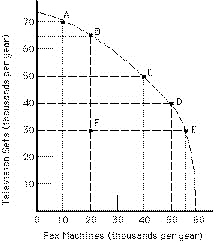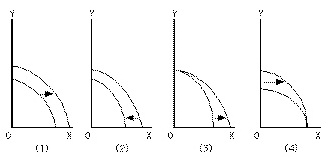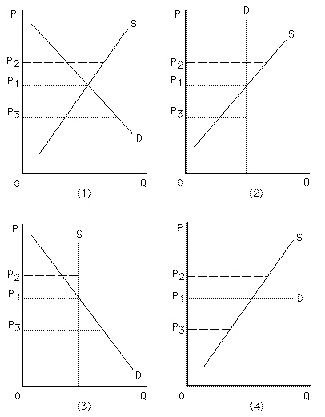EXAM: Principles of Macroeconomics
Multiple Choice
1. There would be no subject of economics (and you would have to drop this course immediately!) if
a. wants were finite.
b. resources were finite.
c. wants were infinite.
d. resources were infinite.
2. In every economy people vie for the economy's rationing device, a process called
a. competition.
b. entrepreneurship.
c. marginal benefit.
d. positive economics.
3. The __________ the opportunity cost of doing something, the __________ likely a person will do that something.
a. lower; less
b. lower; more
c. higher; more
d. higher; less
e. b and d
4. Which of the following is good policy to follow when building and testing a theory?
a. If the theory sounds reasonable, use it.
b. If the theory is logical, use it.
c. If the theory is built on realistic assumptions, use it.
d. If the theory is built on variables that can be quantified precisely, use it.
e. If the theory predicts well, use it.
5. The scientific method and the functioning of a market system are similar in that
a. they are based on experimentally proven tenets.
b. only rich people benefit from them.
c. their success is based on eliminating failures.
d. they are based on a strict religious moral code.
6. Which of the following is an illustration of the law of increasing opportunity costs?
a. As more cars are produced, the opportunity cost of each additional car is greater than for the preceding unit.
b. As more cars are produced, the opportunity cost of each additional car is less than for the preceding unit.
c. As more cars are produced, the opportunity cost of each additional car is the same as for the preceding unit.
d. People pay higher prices for cars the higher the costs of cars.
7. Points inside (or below) the PPF are
a. unattainable.
b. attainable and efficient.
c. attainable but inefficient.
d. attainable and neither efficient nor inefficient.
Exhibit 2-5

8. Refer to Exhibit 2-5. As more fax machines are produced, the opportunity cost of producing them
a. increases.
b. decreases.
c. remains constant.
d. first decreases and then increases.
9. Refer to Exhibit 2-5. "In order to produce one more television set, we must forfeit the production of one fax machine." This statement describes a movement from
a. point C to point D.
b. point D to point E.
c. point E to point F.
d. point E to point D.
e. point D to point C.
10. An increase in resources
a. shifts the PPF inward.
b. shifts the PPF outward.
c. moves the economy up a given PPF.
d. moves the economy down a given PPF.
11. A PPF is more likely to be a downward-sloping curve that is bowed outward than a downward-sloping straight line because most resources are
a. better suited for the production of some goods than others.
b. used efficiently.
c. relatively cheap at low levels of output.
d. used to produce consumption goods.
12. In the production possibilities framework, economic growth is depicted by
a. a shift inward (or to the left) of the frontier.
b. a shift outward (or to the right) of the frontier.
c. the frontier becoming a straight line.
d. the frontier becoming bowed outward.
Exhibit 2-6

13. Refer to Exhibit 2-6. Which graph depicts the consequence of acts of war?
a. (1)
b. (2)
c. (3)
d. (4)
e. none of the above
14. Which scenario below most accurately describes the process by which a technological change can affect employment patterns across industries?
a. A technological advance makes it possible to produce more of good X with less labor. As a result, labor is released from producing good X. Some of this labor ends up producing goods Y and Z.
b. A technological advance makes it possible to produce less of good X with less labor. As a result, labor is released from producing good X. Some of this labor ends up producing good Y.
c. A technological advance makes it possible to produce more of good X with more labor. As a result, more labor is needed to produce good X. There is less labor available to produce goods Y and Z.
d. A technological advance makes it possible to produce more of good X with less labor. As a result, labor becomes more important to the production of good X. More labor ends up producing good X.
e. none of the above
15. Capitalist thinkers believe that prices
a. are useful in helping to ration goods and services.
b. convey information to the buyer.
c. provide incentives.
d. a and b
e. a, b and c
16. A socialist thinker believes that private property is economically undesirable because
a. it cannot provide incentives to its owners.
b. it often provides unfair political or social power to its owners.
c. it shields its owners from the incentives provided by price changes.
d. the government cannot effectively manage property.
17. In the simple circular flow model of economic activity,
a. consumption occurs in the Final Goods and Services Market.
b. production occurs in the Factor Market.
c. "What" to produce is determined in the Final Goods and Services Market.
d. income distribution is determined by business firms.
e. All of the above.
18. In a market system, "To whom" output will be distributed is determinded in the
a. Factor Market.
b. Final Goods and Services Market.
c. Government sector.
d. The Private Business sector.
19. In a barter economy,
a. money is a medium of exchange.
b. coins are used to facilitate trade.
c. money is a store of value.
d. goods and services are traded directly for each other.
e. the money supply consists entirely of precious metals such as gold.
20. The U.S. dollar is
a. backed by gold.
b. backed by the trust that you can exchange it for something of value.
c. an example of fiat money.
d. worthless.
e. b and c.
21. The law of demand states that price and quantity demanded are
a. directly related, ceteris paribus.
b. inversely related, ceteris paribus.
c. independent.
d. positively related, ceteris paribus.
22. If the demand curve for a good shifts leftward,
a. quantity demanded is less at each price.
b. quantity demanded remains constant at each price.
c. quantity demanded is greater at each price.
d. demand is greater at each price.
23. The fundamental reason why most supply curves are upward sloping is that
a. people substitute lower-priced goods for higher-priced goods.
b. the quantity supplied increases as more firms enter the market.
c. a higher price never reduces quantity supplied by enough to lower total
revenue and so higher production is motivated.
d. higher production raises per-unit production cost and so must be motivated by a higher once.
24. If a supply curve shifts rightward, this means
a. suppliers are willing and able to offer less of the good for sale at every price.
b. suppliers are willing and able to offer more of the good for sale at every price.
c. quantity supplied is greater at every price.
d. suppliers are willing and able to offer more of the good for sale only at a particular price.
e. b and c
25. On a supply-and-demand diagram, equilibrium is found
a. where the supply curve intercepts the vertical axis.
b. where the demand curve intercepts the horizontal axis.
c. where the demand and supply curves intersect.
d. at every point on either curve
A 26. At a price for which quantity demanded exceeds quantity supplied, a __________ is experienced, which pushes the price __________ toward its equilibrium value.
a. surplus; downward
b. surplus; upward
c. shortage; downward
d. shortage; upward
Exhibit 3-16

27. Refer to Exhibit 3-16. If there are empty seats for a basketball game at the price P*, the situation is best depicted on graph
a. (1), with P* = P1.
b. (2), with P* = P3.
c. (3), with P* = P2.
d. (3), with P* = P3.
e. (4), with P* = P1.
28. A market is said to be in disequilibrium if
a. it exhibits either a surplus of a shortage.
b. the number of units that individuals are willing to buy exceeds the number of units they can afford.
c. it is a market for an inferior good.
d. none of the above.
`
29. Price ceilings and price floors
a. shift demand and supply curves and therefore have no effect upon the rationing function of prices
b. interfere with the rationing function of prices.
c. make the rationing function of free markets more efficient.
d. cause surpluses and shortages, respectively.
30. An effective price floor will
a. clear the market.
b. result in a shortage.
c. result in a surplus.
d. force some firms in this industry to go out of business.